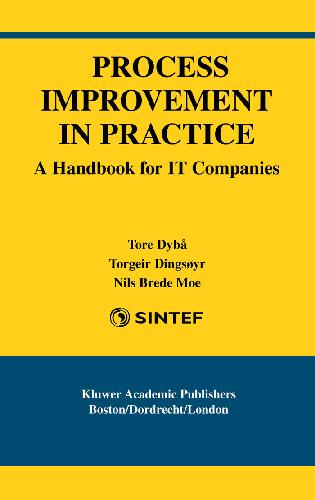Dybå T., Dingsøyr T., Brede Moe N.0-7923-7736-2
Table of contents :
Team DDU……Page 1
Contents……Page 6
Preface……Page 8
1.1 What is the purpose of this handbook?……Page 10
1.2 What is a process……Page 11
1.4 How can process improvement help software organizations……Page 12
1.6 What is special about software development……Page 13
1.8 Overview of this handbook……Page 14
2.2 What does learning mean?……Page 16
2.3 Physical arrangements……Page 19
2.4 Organizational and cultural arrangements……Page 20
2.5 Arrangements for technical infrastructure……Page 23
2.6 Arrangements in the projects……Page 24
2.7 How do we stimulate creativity……Page 28
3.1 Organizing process improvement……Page 30
3.2 A model for project-based experiential learning……Page 31
3.3 Initiating – learning before doing……Page 32
3.4 Executing – learning whilst doing……Page 36
3.5 Closing – learning after doing……Page 40
4. Measurement and Feedback……Page 46
4.1 Process for measurement and feedback……Page 47
4.2 Planning to use data……Page 49
4.3 Data collection……Page 52
4.4 Data analysis……Page 56
4.5 Feedback……Page 60
4.6 Follow-up……Page 63
5.1 Why perform an assessment?……Page 64
5.2 Basic principles……Page 65
5.3 Gap analysis……Page 66
5.4 A participative approach to process assessment……Page 69
6.1 What is a process guide?……Page 74
6.2 Why is a process guide useful?……Page 76
6.4 How to develop a process guide……Page 77
6.5 How to adapt a process guide……Page 81
6.6 How to maintain a process guide……Page 83
7.1 Technique 1: Feedback meeting……Page 86
7.2 Technique 2: GQM abstraction sheet……Page 90
7.3 Technique 3: Mind map……Page 94
7.4 Technique 4: Brainstorming……Page 96
7.5 Technique 5: KJ/ Affinity diagram……Page 100
7.6 Technique 6: Prioritizing……Page 104
7.7 Technique 7: Time-line……Page 106
7.8 Technique 8: Action list……Page 110
7.9 Technique 9: Root cause analysis……Page 112
Bibliography……Page 116
About the Authors……Page 118
Index……Page 120

Reviews
There are no reviews yet.